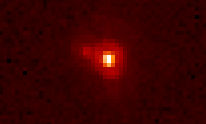 2002 UX25 and satellite, as seen by Hubble | |
| Discovery[1] | |
|---|---|
| Discovered by | Spacewatch (291) |
| Discovery site | Kitt Peak National Obs. |
| Discovery date | 30 October 2002 |
| Designations | |
| (55637) 2002 UX25 | |
| Cubewano (MPC)[2] Extended (DES)[3] | |
| Orbital characteristics[1] | |
| Epoch 4 September 2017 (JD 2458000.5) | |
| Uncertainty parameter 2 | |
| Observation arc | 25.26 yr (9,228 days) |
| Earliest precovery date | 12 October 1991 |
| Aphelion | 48.491 AU |
| Perihelion | 36.485 AU |
| 42.488 AU | |
| Eccentricity | 0.1413 |
| 276.95 yr (101,157 days) | |
Average orbital speed | 4.54 km/s |
| 295.71° | |
| 0° 0m 12.96s / day | |
| Inclination | 19.484° |
| 204.68° | |
| ≈ 5 September 2066[4] ±3 days | |
| 279.00° | |
| Known satellites | 1 (ø: 190–260 km)[5][6] |
| Physical characteristics | |
| 665±29 km[7] 659±38 km[8] | |
| Mass | (1.25±0.03)×1020 kg[6] |
Mean density | 0.82±0.11 g/cm3 (assuming equal densities for primary and satellite)[6] 0.80±0.13 g/cm3[8] |
Equatorial surface gravity | 0.075 m/s2 |
Equatorial escape velocity | 0.227 km/s |
| 14.382±0.001 h[9] | |
| 0.107+0.005 −0.008[7] 0.1±0.01[8] | |
| Temperature | ≈ 43 K |
| B–V=1.007±0.043[10] V−R=0.540±0.030[10] V−I=1.046±0.034[10] | |
| 19.8 [11] | |
| 3.87±0.02,[9] 4.0[1] | |
(55637) 2002 UX25 (provisional designation 2002 UX25) is a trans-Neptunian object that orbits the Sun in the Kuiper belt beyond Neptune. It briefly garnered scientific attention when it was found to have an unexpectedly low density of about 0.82 g/cm3.[12] It was discovered on 30 October 2002, by the Spacewatch program;[13] as of August 2024, the object has yet to be named.
2002 UX25 has an absolute magnitude of about 4.0,[1] and Spitzer Space Telescope results estimate it to be about 681 km in diameter.[14] The low density of this and many other mid sized TNOs implies that they have likely never compressed into fully solid bodies, let alone differentiated or collapsed into hydrostatic equilibrium, and so are highly unlikely to be dwarf planets.[15]
- ^ a b c d Cite error: The named reference
jpldatawas invoked but never defined (see the help page). - ^ Cite error: The named reference
MPEC 2009-C70was invoked but never defined (see the help page). - ^ Cite error: The named reference
Buiewas invoked but never defined (see the help page). - ^ JPL Horizons Observer Location: @sun (Perihelion occurs when deldot changes from negative to positive. Uncertainty in time of perihelion is 3-sigma.)
- ^ Cite error: The named reference
IAUC8812was invoked but never defined (see the help page). - ^ a b c Cite error: The named reference
Brown2013was invoked but never defined (see the help page). - ^ a b Cite error: The named reference
TNOsCool8was invoked but never defined (see the help page). - ^ a b c Cite error: The named reference
Brown2017was invoked but never defined (see the help page). - ^ a b Cite error: The named reference
Johnstonwas invoked but never defined (see the help page). - ^ a b c Cite error: The named reference
Hainaut2012was invoked but never defined (see the help page). - ^ Cite error: The named reference
AstDyswas invoked but never defined (see the help page). - ^ Cite error: The named reference
cowenwas invoked but never defined (see the help page). - ^ Cite error: The named reference
MPEC2002-V08was invoked but never defined (see the help page). - ^ Cite error: The named reference
spitzerwas invoked but never defined (see the help page). - ^ W.M. Grundy, K.S. Noll, M.W. Buie, S.D. Benecchi, D. Ragozzine & H.G. Roe, 'The Mutual Orbit, Mass, and Density of Transneptunian Binary Gǃkúnǁʼhòmdímà ((229762) 2007 UK126)', Icarus (forthcoming, available online 30 March 2019) Archived 7 April 2019 at the Wayback Machine DOI: 10.1016/j.icarus.2018.12.037,